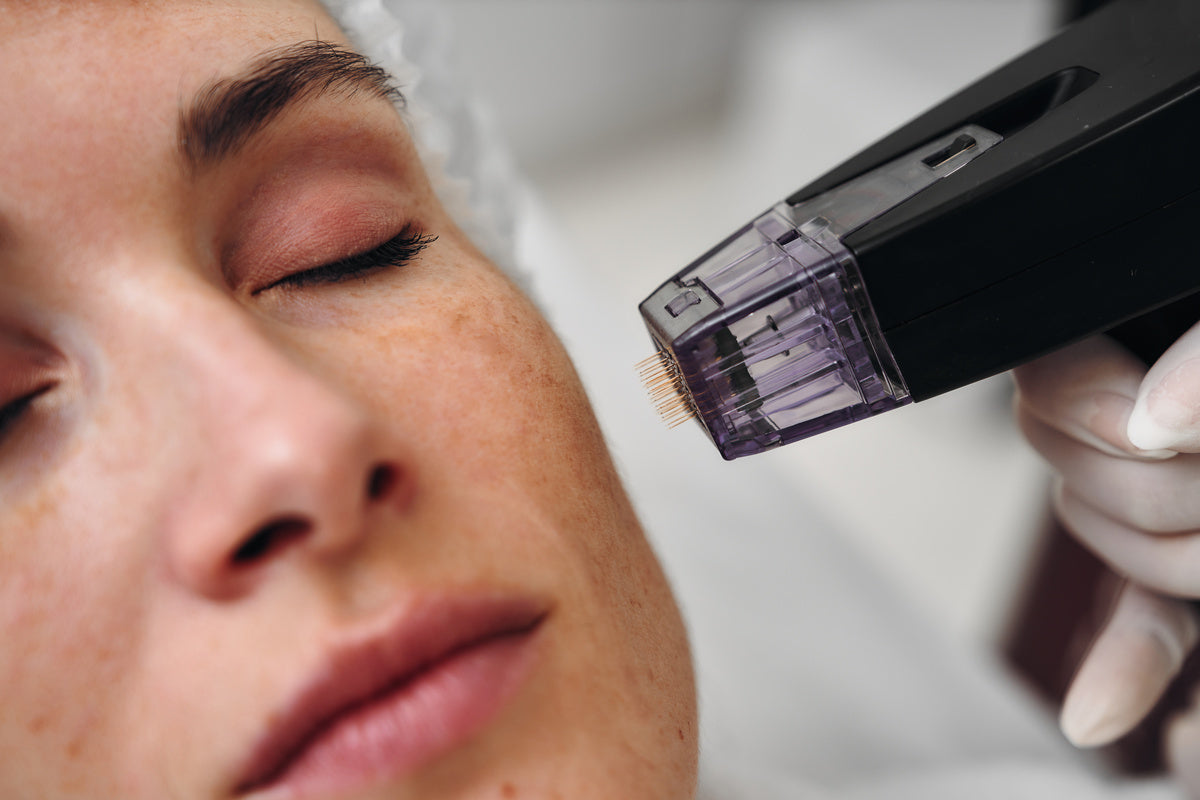Blog > All
Does Microneedling Cause Bleeding?
Written by Our Editorial Team
6 min read
00
DAYS D00
HOURS H00
MINUTES M00
SECONDS S

Does microneedling cause bleeding? It can, but it’s not always necessary for effective results. Light pinpoint bleeding might occur depending on the needle depth and pressure, but excessive bleeding is avoidable with the right tools and technique.
In this article, we’ll explain why bleeding happens, whether it’s essential, and how you can enjoy all the benefits of microneedling safely at home with the Qure Skincare Micro Infusion. Let’s dive into the details and help you achieve glowing, healthy skin without any guesswork!
What this article covers:
Microneedling is a minimally invasive skin treatment that involves tiny, fine needles creating micro-injuries on the skin’s surface. It’s like giving your skin a wake-up call to produce more collagen and elastin, which are the holy grail for a glowing, youthful complexion.
Whether you’re tackling fine lines, acne scars, or even hair growth, microneedling works by encouraging your body’s natural healing process. Now, here’s where it gets better: microneedling is NOT the same as dermarolling. Dermarolling is the old-school cousin, less effective, and often harder to control.
At Qure Skincare, we’ve leveled up with our Micro Infusion facial system. Featuring 24K gold-plated, clinical-grade needles and a serum packed with skin-loving ingredients, it delivers professional-grade results—all from the comfort of your couch.
From our experience, this innovation offers the benefits of traditional microneedling and more, without the hefty price tag of clinic visits.
Let’s clear this up: microneedling might cause light pinpoint bleeding, but it’s not a deal-breaker for results. According to our research and years of hands-on experience, whether you see blood typically depends on the depth of the needles and how much pressure is applied.
Here’s a breakdown to help you understand what’s going on beneath the surface:
Pinpoint bleeding can happen when needles are around 1.5 mm or longer. Why? These needles reach the dermis, the deeper layer of your skin, where blood vessels live. This creates tiny micro-injuries that may lead to a few specks of blood.
This is a normal part of the process and nothing to stress about. Pinpoint bleeding is a signal that your body’s natural wound-healing response is kicking in. This response helps stimulate collagen and elastin production—two major players in firmer, healthier skin.
With our Micro Infusion device, we use 0.5 mm needles. These don’t go deep enough to cause bleeding, making them a perfect choice for those who want results without any mess. Plus, this shallower depth is still highly effective for boosting skin texture, hydration, and radiance when paired with the right serum.
Get the latest from Qure
Too much blood? That’s a sign something’s off. Excessive bleeding during microneedling typically happens if the needles are too long or you’re applying too much pressure.
While it might seem like “no pain, no gain,” pushing too hard can actually damage your skin. Overdoing it increases the risk of side effects like irritation, scarring, or prolonged healing times.
From our experience, staying within the sweet spot of 0.5 mm to 1.5 mm needle depth is key to getting great results while staying safe.

If you’re using an at-home device, always follow the instructions closely. Your skin deserves gentle care, not a workout session. At Qure Skincare, we’ve designed our tools and serums to work seamlessly at optimal depths, so you don’t have to second-guess yourself. Our goal? Deliver glowing skin without unnecessary risks.
Here’s the good news: bleeding is absolutely not required to see benefits from microneedling, whether you’re microneedling freckles and hyperpigmentation, or fine lines and wrinkles.
Results show that even without visible bleeding, microneedling can still improve collagen production, enhance product absorption, and refine your skin’s texture.
In fact, shallower microneedling can be just as effective—especially when combined with a specially formulated serum like ours. The magic lies in those micro-channels created by the needles, which help active ingredients penetrate deeper into the skin. Think of it like a VIP pass for your skincare.
From our experience, achieving radiant skin doesn’t have to come with excessive microneedling pain or mess. But, what does microneedling feel like?
With a device like our Micro Infusion and its 0.5 mm needles, you can enjoy all the benefits of microneedling without any real discomfort. Your skin will thank you for it!
Microneedling can cause some light pinpoint bleeding, but it’s not a must for achieving beautiful results. The key is using the right needle depth, applying gentle pressure, and pairing your treatment with a high-quality serum to maximize skin benefits.
At Qure Skincare, we’ve designed our Micro Infusion to give you all the advantages of microneedling at home—safely and effectively—without the worry of bleeding or overdoing it.

Ready to take your skincare routine to the next level? Explore Qure Skincare today and see how easy glowing skin can be!
Yes, microneedling is known to improve the appearance of acne scars by stimulating collagen and promoting skin renewal.
Many users notice smoother, more radiant skin within a few weeks. However, long-term benefits like improved texture and reduced fine lines may take a few months with consistent use.
It’s best to wait at least 24 hours after microneedling before applying makeup to allow your skin to heal and avoid irritation.
When using Qure Skincare’s Micro Infusion tool, we recommend a microneedling frequency of once every 2 weeks for the best results after microneedling.
If you want to learn more, why not check out these articles below:
Most Popular Posts